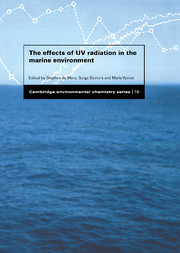Book contents
- Frontmatter
- Contents
- Contributors
- Preface
- 1 Enhanced UV radiation – a new problem for the marine environment
- 2 UV physics and optics
- 3 Spectral weighting functions for quantifying effects of UV radiation in marine ecosystems
- 4 Marine photochemistry and its impact on carbon cycling
- 5 Photochemical production of biological substrates
- 6 Mechanisms of UV damage to aquatic organisms
- 7 Strategies for the minimisation of UV-induced damage
- 8 UV radiation effects on heterotrophic bacterioplankton and viruses in marine ecosystems
- 9 Effects of UV radiation on the physiology and ecology of marine phytoplankton
- 10 Impact of solar UV radiation on zooplankton and fish
- 11 Implications of UV radiation for the food web structure and consequences on the carbon flow
- Index
2 - UV physics and optics
Published online by Cambridge University Press: 20 August 2009
- Frontmatter
- Contents
- Contributors
- Preface
- 1 Enhanced UV radiation – a new problem for the marine environment
- 2 UV physics and optics
- 3 Spectral weighting functions for quantifying effects of UV radiation in marine ecosystems
- 4 Marine photochemistry and its impact on carbon cycling
- 5 Photochemical production of biological substrates
- 6 Mechanisms of UV damage to aquatic organisms
- 7 Strategies for the minimisation of UV-induced damage
- 8 UV radiation effects on heterotrophic bacterioplankton and viruses in marine ecosystems
- 9 Effects of UV radiation on the physiology and ecology of marine phytoplankton
- 10 Impact of solar UV radiation on zooplankton and fish
- 11 Implications of UV radiation for the food web structure and consequences on the carbon flow
- Index
Summary
The discovery and persistence of regions of ozone depletion over large areas of the earth's surface (the ‘ozone hole’) has fuelled a significant increase in interest about UV radiation (UVR). This interest ranges from investigations focused on atmospheric interactions and the physics of light transmission (WMO, 1988, 1989, 1991, 1995, 1999; UNEP, 1992) to photobiological effects and agricultural, economic and social impacts (UNEP, 1991, 1994, 1998). The purpose of this chapter is to present some background information about the solar spectrum and introduce a few of the fundamental physical concepts related to UV in the atmosphere (Section 2.1) and underwater (Section 2.2).
Unless other sources are mentioned, the modelled irradiances at the earth's surface used in Section 2.1 were calculated with a two-stream radiative transfer model (Frederick & Lubin, 1988), the values of measured irradiance were provided by the National Science Foundation (NSF) Radiation Monitoring Program (Booth, 1990–1997), and the values of total column ozone by Nimbus 7/Meteor 3, Total Ozone Mapping Spectrometer (TOMS) data (McPeters, 1994).
Atmospheric UV radiation
Extraterrestrial solar radiation encompasses a wide region of the electromagnetic spectrum and exhibits a distribution similar to the emission of a black body at a temperature of 5800 K (Koller, 1965; Madronich, 1993). Fortunately, for the purposes of this chapter, only a portion of the solar spectrum needs to be considered. The visible portion of the total solar radiation spectrum covers a region of the spectrum from 400 to 700 nm. Wavelengths from 10 to 400 nm correspond to the UV region and wavelengths higher than 700 nm correspond to the infrared region.
- Type
- Chapter
- Information
- The Effects of UV Radiation in the Marine Environment , pp. 35 - 71Publisher: Cambridge University PressPrint publication year: 2000
- 11
- Cited by

